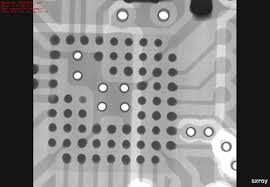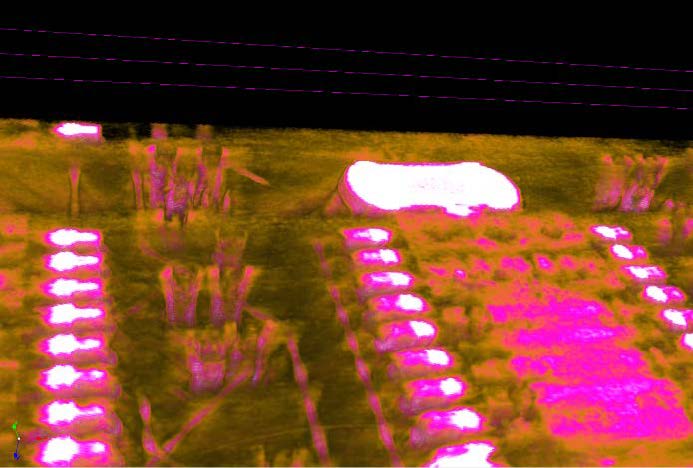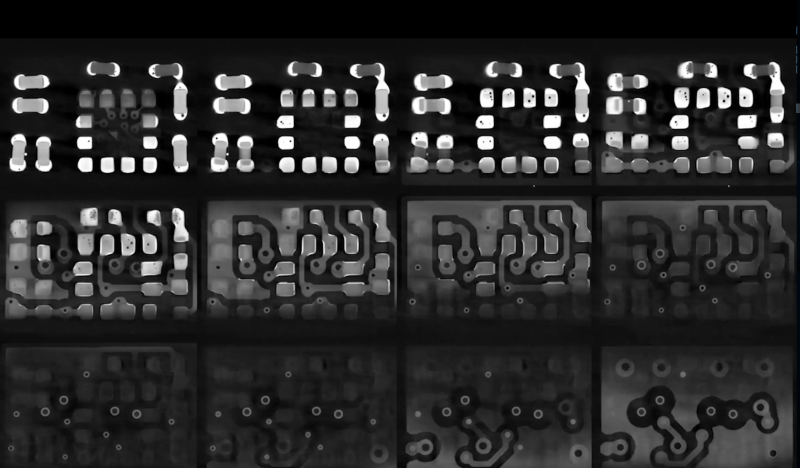At risk of getting any ASMR buffs who might be reading cranky because there’s no audio, [Chris], or [@no1089] on Twitter, has gifted us with this visually stunning scan of his Maxim MAX86160 in-ear heart monitor mounted on a rigidflex PCB. You can take a look, in the video below the break.
If you’re wondering why anyone would scan a board, other than boredom, know that it’s actually quite common. X-Ray machines are commonly used as a quick, passive way to check a board that’s fresh off the production line. These aren’t the X-Rays like those of broken bones you’re (hopefully not too) used to seeing though, they’re Computed Tomography scans (CT scans, CAT scans), in effect just 3D X-Rays.

For electronics manufacturers and assemblers, CT scans are incredibly useful because they provide a non-destructive way to check for errors. For example, how do you know if that middle BGA pin is actually soldered correctly? You could run a functional test and make sure everything is working (at least, everything you check), but that takes time. The longer it takes to validate, the higher the manufacturing cost. In manager speak: “cost bad. Fast good.”
It’s also common to use a CT scan to create a full 3D model of a board. This makes it easy to check every little detail, especially the ones that are visually obscured by surface mount devices or critical signal paths that are buried under board layers.

If you want to geek out on CT scans, you can learn more about the lab that did this scan or by wading into this unclassified research paper from Australia’s Cyber and Electronic Warfare Division.
But we know you really want more of this video, but better. And we’ve got the goods. For the chill folk among you, here’s a 55-minute version without all the CT scan info cluttering the screen. For those of you currently blasting eDM in your headphones, here’s a 30 second clip of it looping at ~5x speed. Eat your heart out:
Because YouTube’s compression algorithm did some ugly work on these, here’s a clip on Vimeo as well.

















I’ve had the pleasure of x-raying various devices at the dentist, and using a very special GE CT scanner to take several scans of my accordion and making 3d reconstructions of what was inside.Here’s a reddit link (sorry, I know) to the pictures I got from it:
https://www.reddit.com/r/Accordion/comments/9bksyf/long_story_short_i_got_my_lira_model_10_ct_scanned/
CT scanners and x-ray equipment for medical use don’t usually have incredibly fine resolution for this kind of scale, but the fact it’s possible at all is amazing.
What’s the difference between a CT and CAT scan? One is axial? They’re both x-ray tomogrophy, right? I must have a misconception, just trying to ratify it.
There’s no difference. They both take a bunch of X-Ray images (projections) around the object (or patient) and produce a a set of ‘slices as the output.
There’s also Micro-CT or XMT or mXMT or any other variant of the initials – this is just CT but with higher resolution.
No difference. Two words, same thing.
The same thing. Computed Tomography / Computerised Axial Tomography
https://en.wikipedia.org/wiki/CT_scan
I suppose you could argue that CAT was a sub-set of CT, in that you could choose a direction other than Axial.
Computerised Coronal Tomography / Computerised Sagittal Tomography
https://en.wikipedia.org/wiki/Anatomical_plane
There’s no difference between a CT scan and a CAT scan. They just changed the name for whatever reason.
A cat scan is where you put a cat on a flatbed scanner… https://thecatscan.tumblr.com/
I briefly worked for a company that makes X-ray microscopes for this purpose. (on the mechanical design of the X-ray guns)
Perhaps it is a cost thing, but the Stellenbosch setup seems a bit “Heath Robinson” when dedicated instruments have been around for 20 years or more.
https://www.nordson.com/en/divisions/dage/x-ray-inspection
we just got a 5 axis industrial x-ray at work, I jumped at the chance to be trained on how to use it, and its pretty darn kewl
when I worked at the manufacturer they had a Christmas Quiz where you had to figure out what things were from the X-ray. One particularly difficult one was a box of ball point pens. Without a sense of scale the tungsten balls made something that looked like an oddly sparse and irregular BGA.
How useful various scanning techniques can be when it comes to reverse-engineering (for instance, retro ICs) vs decapping?
For the benefit of those who, like me, loathe people who blandly assume you know every acronym:
https://en.wikipedia.org/wiki/Autonomous_sensory_meridian_response